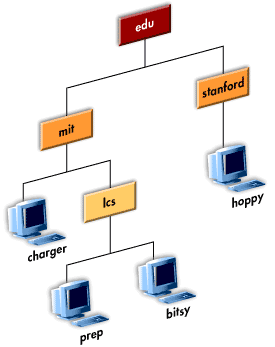| Lesson 8 | The Domain Name System |
| Objective | Describe the function of the Domain Name System. |
Redhat Linux Domain Name System
The Domain Name System (DNS) maps names to IP addresses for the same reason port names map to numbers, people are better with names than numbers.
For example, it is easier for a user to remember www.mit.edu than to remember 18.181.0.31. With DNS, the computer does not require the IP number because it can always look up any name you give it.
Naming hosts
To name hosts, DNS uses a tree-oriented classification scheme, and a notation similar to the dotted quad syntax.
For example, your friend's email address is at:
Reading left to right, the name before the first dot is the host name, the name after the last dot is the top-level domain, and all intervening names are networks in between the host and the top-level domain. In example above, the DNS name "charger.mit.edu" indicates a host named "charger" in the "mit" network and the "edu" top-level domain.
The following MouseOver shows the parts of a DNS tree:
charger.mit.edu
Reading left to right, the name before the first dot is the host name, the name after the last dot is the top-level domain, and all intervening names are networks in between the host and the top-level domain. In example above, the DNS name "charger.mit.edu" indicates a host named "charger" in the "mit" network and the "edu" top-level domain.
The following MouseOver shows the parts of a DNS tree:

DNS Viewed as Tree
Whenever a DNS name has a host name, a network name, and a top-level domain (as in "charger.mit.edu"), the name is "fully-qualifed." Fully-qualified domain names (FQDN) describe a single host on the Internet. Examples of other fully-qualified domain names include:
The next lesson discusses network servers.
Whenever a DNS name has a host name, a network name, and a top-level domain (as in "charger.mit.edu"), the name is "fully-qualifed." Fully-qualified domain names (FQDN) describe a single host on the Internet. Examples of other fully-qualified domain names include:
The next lesson discusses network servers.
Matching Parts Dns Name
Before moving on to the next lesson, click the link below to read about parts of a DNS name.
Matching Parts DNS Name
Matching Parts DNS Name
